Neo-Victorian transcorporeality: Narrating Julia Pastrana's body
Main Article Content
Abstract
Julia Pastrana (1834-1860) features prominently in neo-Victorian biofiction, which is probably indebted to her tragic life and posthumous exploitation in the hands of her husband-manager Theodore Lent. Pastrana’s career surpassed her death when Lent continued touring her embalmed body – an exhibition that would outlive him into the late twentieth century. Although Pastrana was repatriated and buried in 2013, she did not reach the final rest as her story continues to fascinate twentieth-first century audiences. This essay focuses on the ways in which Pastrana’s body has been constructed and produced narratively building on multiple discourses that straddle different disciplines and cultural settings that span three centuries. The two biofictional novels Julia Pastrana (2007) by Sandy Olson and Julian Fenech, and The Orphans of the Carnival (2016) by Carol Birch will be analysed through the lens of transcorporeality (Alaimo, 2010). By drawing on twenty-first century feminist theory on the body that has placed emphasis on the body as a dynamic and travelling concept through its orientations and intersectionality, my principal aim is to provide new insights into the ways in which contemporary novelists have rendered Pastrana’s body and to examine to which ends.
Downloads
Article Details
An open-access CREATIVE COMMONS copyright license is used. Those authors whose works are published by this journal, accept the following terms:
- Authors will retain their copyright and guarantee the Journal the right to first publish their work, which will simultaneously be subject to the Creative Commons Recognition License CC BY SA that allows third parties to share the work, provided that its author and first publication is indicated.
- Authors may adopt other non-exclusive license agreements for the distribution of the published version of the work (e.g., deposit it in an institutional telematics file or publish it in a monographic volume) provided that the initial publication in this journal is indicated.
- Authors are allowed and recommended to disseminate their work over the Internet (e.g. in institutional telematics files or on their website) before and during the submission process, which can produce interesting exchanges and increase quotes of the published work.
References
Adams, Rachel. 2001. Sideshow U.S.A.: Freaks and the American Cultural Imagination. Chicago: U of Chicago P.
Ahmed, Sara. 2006. Queer Phenomenology: Orientations, Objects, Others. Durham: Duke UP.
Ahmed, Sara and Jackie Stacey, eds. 2001. Thinking Through the Skin. London: Routledge.
Alaimo, Stacy. 2010. Bodily Natures: Science, Environment and the Material Self. Bloomington: Indiana UP.
Birch, Carol. 2016. Orphans of the Carnival. Edinburgh: Canongate.
Bondeson, Jan. 1997. A Cabinet of Medical Curiosities. London: I. B. Tauris.
Davies, Helen. 2015a. Neo-Victorian Freakery: The Cultural Afterlife of the Victorian Freak Show. Basingstoke, Palgrave Macmillan.
Davies, Helen. 2020b. “Us and Them? Joseph Merrick in Neo-Victorian Children’s Fiction”. In Neo-Victorian Biofiction: Reimagining Nineteenth-Century Historical Subjects, eds. Marie-Luise Kohlke and Christian Gutleben. Amsterdam: Brill/Rodopi, 167-187.
Deleuze, Gilles and Felix Guattari. 1999. A Thousand Plateaus: Capitalism and Schizophrenia. Trans. Brian Mssumi. London: The Athlone Press.
EMBALM. n.d. Merriam-Webster’s Dictionary. https://www.merriam-webster.com/dictionary/embalm
Garland, Rosie. 2013. The Palace of Curiosities. London: HarperCollins.
Garland-Thomson, Rosemarie. 2003. “Making Freaks: Visual Rhetoric and the Spectacle of Julia Pastrana”. In Thinking through the Body, eds. Jeffrey Jerome Cohen and Gail Weiss. New York: State University of New York Press, 129-143.
Gatens, Moira. 1999. “Power, Bodies and Difference”. In Feminist Theory and the Body: A Reader, eds. Janet Price and Margrit Shildrick. Edinburgh: Edinburgh UP, 227-234.
Gerber, David A. 1992. “Volition and Valorization in the Analysis of the ‘Career’ of People Exhibited in Freak Shows”. Disability, Handicap and Society, 1.7: 53-69.
Grosz, Elizabeth. 2005. Time Travels: Feminism, Nature, Power. Durham and London: Duke UP.
Guillaume, Laura and Joe Hughes, eds. 2011. Deleuze and the Body. Edinburgh: Edinburgh UP.
Gylseth, Christopher Hals and Lars O. Toverud. 2003. Julia Pastrana: The Tragic Story of the Victorian Ape Woman. Trans. Donald Tumasonis. Sparkford: Sutton.
Kohlke, Marie-Luise and Christian Gutleben. 2020. “Taking Biofictional Liberties: Tactical Games and Gambits with Nineteenth-Century Lives”. In Neo-Victorian Biofiction: Reimagining Nineteenth-Century Historical Subjects, eds. Marie-Luise Kohlke and Christian Gutleben. Amsterdam: Brill/Rodopi, 57-78.
Longhurst, Robyn. 2000. Bodies: Exploring Fluid Boundaries. London: Routledge.
“Marital Rape Laws by Country”. n.d. In Wikipedia. https://en.wikipedia.org/wiki/Marital_rape_laws_by_country.
“Mexican ‘Ape Woman’ Buried 150 Years after Her Death”. (2013, February 13), The Guardian. Retrieved June 6, 2022, from https://www.theguardian.com/world/2013/feb/13/mexican-ape-woman-buried.
Olson, Sandy and Julian Fenech. 2012. Julia Pastrana: A Novel [2007]. Smashwords.
Pettersson, Lin. 2016. “The Deviant Body in Neo-Victorian Literature: A Somatechnical Reading of the Freak in Rosie Garland’s The Palace of Curiosities (2013)”. Journal of English Studies, 14: 183-201.
Price, Janet and Margrit Shildrick. 1999. “Openings on the Body: A Critical Introduction”. In Feminist Theory and the Body: A Reader, eds. Janet Price and Margrit Shildrick. Edinburgh, Edinburgh UP, 1-14.
Shildrick, Margrit. 1997. Leaky Bodies and Boundaries: Feminism, Postmodernism and (Bio)Ethics. London: Routledge.
Stern, Rebecca. 2008. “Our Bear Women, Ourselves: Affiliating with Julia Pastrana”. In Victorian Freaks: The Social Context of Freakery in Britain, ed. Marlene Tromp. Ohio: Ohio State UP, 200-233.
Tomaiuolo, Saverio. 2018. Deviance in Neo-Victorian Culture: Canon, Transgression, Innovation. Basingstoke: Palgrave Macmillan.
Weiss, Gail. 1999a. Body Images: Embodiment as Intercorporeality. New York and London: Routledge.
Weiss, Gail. 2006b. Refiguring the Ordinary. Bloomington: Indiana UP.
Wilson, Charles. 2013, February 13. “An Artist Finds a Dignified Ending to an Ugly Story”. New York Times. Retrieved June 5, 2022, from https://www.nytimes.com/2013/02/12/arts/design/julia-pastrana-who-died-in-1860-to-be-buried-in-mexico.html


